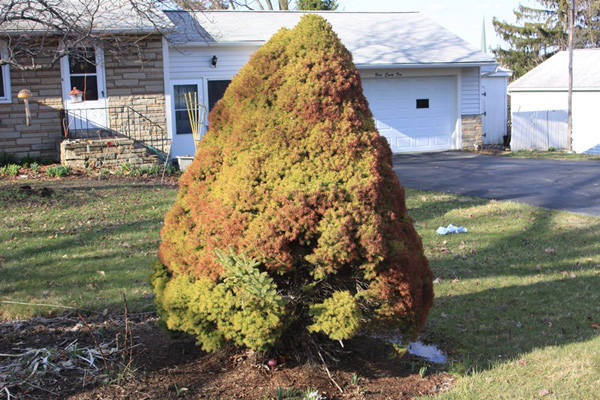Prevent browning on evergreens with proper care this winter

Prevent browning on evergreens with proper care this winter
By David Sprague
OSU Ext. Master Gardener Volunteer
Brown needles and leaves on evergreen trees and shrubs may not show until spring, but it is most likely the result of damage over the winter.
One of the most common types of damage during the winter is desiccation, also known as winter burn or winter scorch. Desiccation injury occurs when water is lost from evergreen plants to the atmosphere faster than it can be replaced through absorption of water by the roots.
All trees and shrubs lose water during normal metabolic processes, even in winter. During the growing season when trees are in full foliage, large amounts of water are lost through their leaves via a process called transpiration. The water lost in transpiration is replaced by water from the soil.
During winter months, the metabolic processes are slowed, but evergreens continue to lose water at a higher rate than deciduous trees.
Evergreens will lose water through their needles, leaves and to a lesser extent from exposed bark, twigs and buds. If the soil around the plant is dry or frozen, the plant cannot replace this lost water, and injury or death to the dehydrated parts can occur. Wind and sunlight can accelerate desiccation by increasing water loss from the needles and leaves. Reflective surfaces such as white buildings, concrete paving or light-colored stones used as mulch can also contribute to desiccation.
The needles and leaves of desiccated plants often keep their green color until the weather warms in the spring. Then, they turn yellow or reddish-brown at the tip and die back to the base. Sometimes this damage is only on one side of the tree or shrub, the side facing the prevailing wind and/or the side receiving the most sunlight.
Other than watering, no action needs to be taken when the symptoms first appear. Limbs or branches that are brown and appear dead may have buds for new growth. Pruning should be delayed until spring is fully established to see if new growth materializes. If the limb or branch has no new growth, it should be pruned out.
Winter desiccation is best prevented by maintaining adequate soil moisture. This means giving the plants a good watering in fall before the ground freezes. Watering can be done in the winter if the temperature is above freezing and the soil isn’t frozen.
Applying a 2- to 3-inch layer of mulch over the root zone helps maintain soil moisture and protects the plant from cold temperatures. Plants set in windy locations should be protected by wind breaks. Do not cover the plant with an airtight container.
Anti-desiccant sprays can be effective against moisture loss on evergreens. Anti- desiccants form a moisture barrier over the plant surface and hold in water or slow its outward movement. To be effective, these sprays need to be applied when air temperatures are above freezing for several hours.
Also, plants hardy for the local climate and soil conditions, i.e. native plants, usually do better over winter than nonnative plants.
More information is available atgo.osu.edu/desiccation.
 43
43

